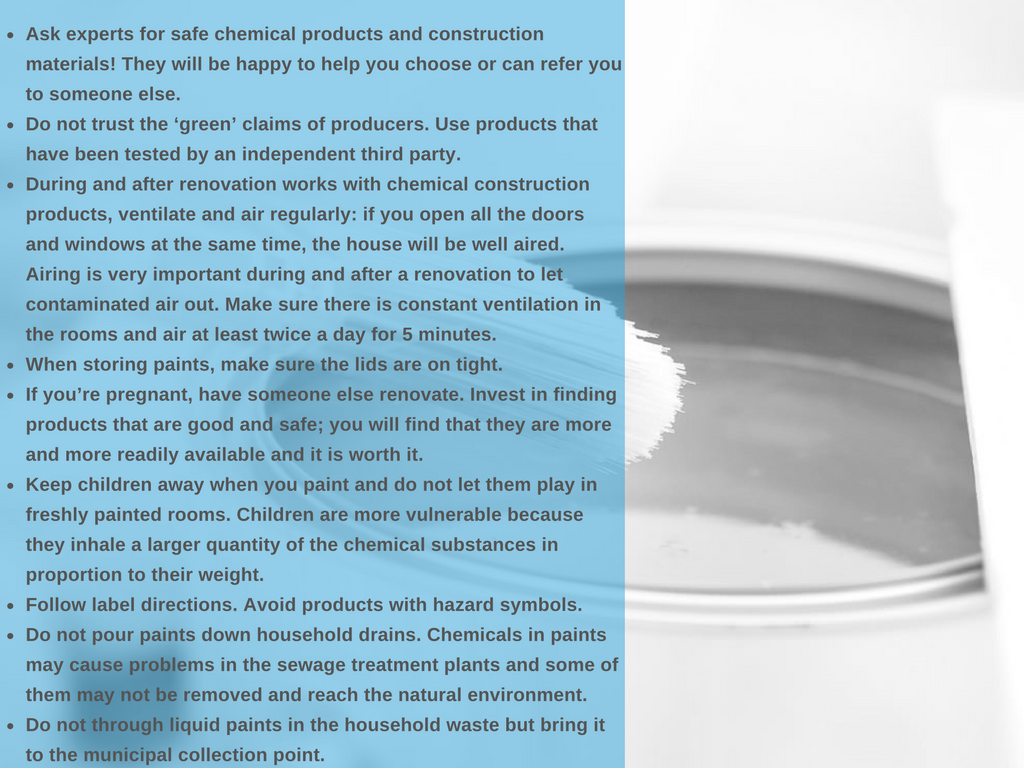What is important to know about paints and varnishes?
Many paints, varnishes, flooring and wallpaper can contain chemicals which can be harmful to your health and the environment. These hazardous substances can be released from paints and varnishes during their use and directly affect the indoor quality in your home.
The problem
We are very used to quick-drying, colourful and abrasion-resistant paints. Their properties result from the use of a variety of different chemicals in the paints and varnishes. Some of them could cause damage to human health and the environment when not properly used, stored or disposed of.
The most important group of chemicals of concern in paints are called volatile organic compounds (VOCs). They evaporate into the indoor air – you can smell them while painting – and when they are inhaled may cause health problems. Other possibly hazardous chemicals have functions as biocides, pigments or provide a specific surface like gloss, structure etc.
Hazardous chemicals are used as ingredients in paints and varnishes for the following purposes:
- As resins or binders: components that cause the formation of a film of paint/varnish on the surface that is painted or varnished. The main types of chemicals used as binders are oils, alkyds, and waxes.
- As solvents: components which keep the paint or varnish in liquid form until it is applied. Solvents can be VOCs or water (water-based or solvent-based paints and varnishes).
- As pigments and fillers: components that determine the colour and opacity (covering power) of the product and some other properties.
- As additives: different ingredients which are added in small amounts to provide specific properties; the function could support the convenience of using the paints (prevent moulding, thickness of the paint) or could support specific visual properties, like surface structure, glossyness etc..
To achieve the above functions, different chemicals could be used. Examples of chemicals with hazardous properties used as solvents are white spirit, toluene or ethylbenzene. Chlorinated paraffins, n-hexane, ethyl methyl ketoxime are used as additives and binders.
WHY ARE HAZARDOUS CHEMICALS USED IN PAINTS AND VARNISHES?
Tips & tricks

Possible health effects
Uses
Various dyes and pigments
Hazardous chemicals
Aniline
Possible health effects
Very toxic, carcinogenic and mutagenic
Used in products
Dolls
Uses
Surfactant
Hazardous chemicals
Nonylphenol (ethoxylates)
Possible health effects
Endocrine disruptor, persistent, accumulates in the environment
Used in products
Textile paper and pulp processing, paints, resins, glue, protective coatings, detergents, animal medicine, pesticides, steel production
Uses
Solvents, detergents, medicine, anti-freeze
Hazardous chemicals
Organic solvents (Xylene, benzene (turpentine), n-hexane, hydro-treated heavy naphtha, ligroin, naphtha (petroleum), hydrodesulfurized heavy)
Possible health effects
Harmful to reproduction, unborn child, causes skin irritation and eczema
Used in products
Plaster paints, acrylic paints, enamel, wood varnish, glue, resins, detergents, paint and varnish remover, hydrolic liquids
Uses
Synthetic material, soft or rigid, applied for many uses
Hazardous chemicals
PVC
Possible health effects
8-16 substances in PVC can cause different types of damage, such as dipentylphthalate (carcinogenic, toxic, disrupting the reproductive system, CMR, damaging to the unborn child) cadmium, lead and vinylchloride (carcinogenic, on combustion dioxin is released
Used in products
Piping, textile (t-shirts) gloves, (building) plastics, toys
Uses
Slows the combustion process by several minutes
Hazardous chemicals
Brominated flame retardants
Possible health effects
PBT, some kinds are also classified as CMR, some disrupt the hormone system
Used in products
Polystyrene, textile (furniture fabrics), stuffing of furniture and mattresses wrappings, insulation materials, plastics
Uses
Intended to kill, deter or render harmless organisms (plants and animals) considered harmful
Hazardous chemicals
Biocides (diuron, 5-chloro-2-methyl-4-isothiazolin-3-one)
Possible health effects
Toxic to living organisms, skin irritation, burns, allergies
Used in products
Wood and wood products, fungicidal paint etc
Uses
Component in formulation of epoxy resins, formerly also used as a fungicide
Hazardous chemicals
Bisphenol A
Possible health effects
Endocrine disruptor, possible reprotoxic effects, is irritating to eyes, lungs and skin
Used in products
Plastics, resins, epoxy glues
Uses
Anti-skinning, thickening agents in paints
Hazardous chemicals
Additives in paints (Cobalt bis (2-ethylhexanoate), ethylmethylketoxime, 2-butanone oxime, zinc phosphate)
Possible health effects
Irritant to skin, eyes, respiratory system, possible carcinogen, hazardous to the environment
Used in products
Paints, primer, especially organic solvent-based
Uses
Stabilising agents, enhancing adhesion
Hazardous chemicals
Isocyanates
Possible health effects
Irritating to eyes and respiratory tract
Used in products
Used in production of rubbers and adhesives

